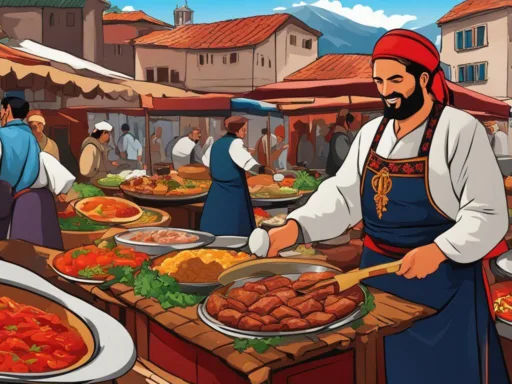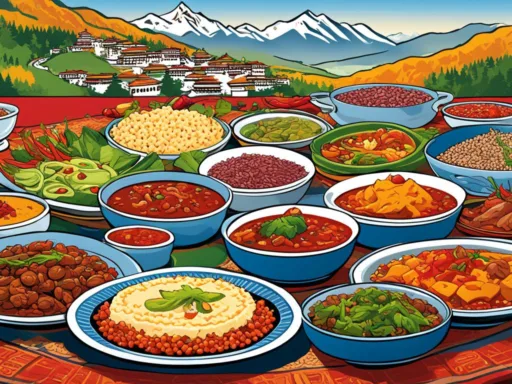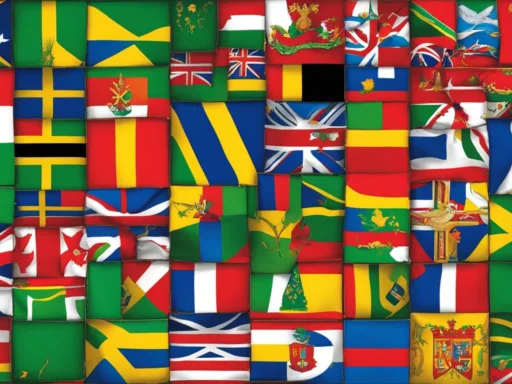In the enchanting islands of São Tomé and Príncipe, a staggering 98.4% of the population communicates in Portuguese, painting a vivid picture of linguistic unison. Yet, beneath the surface of this seemingly uniform linguistic landscape lies a treasure trove of linguistic diversity São Tomé & Príncipe is renowned for. Far from being a monoglot nation, this equatorial paradise is a symphony of dialects and languages, ranging from centuries-old native creoles to the global tongues of English and French introduced in classrooms. The intricate array of languages spoken in São Tomé & Príncipe underscores the richness of its cultural tapestry—influenced by the ebb and flow of colonial history, immigration, and indigenous traditions.
The threads of the official languages São Tomé & Príncipe weaves run deep, connecting inhabitants not only to each other but also to their multifaceted heritage. From the ubiquitous Portuguese to the niche creoles that carry the whispers of the islands’ past, each linguistic variant contributes its unique inflection to the archipelago’s collective voice.
Key Takeaways
- Portuguese serves as the primary unifying language for the vast majority of São Tomé and Príncipe’s populace.
- Local creole languages embody the linguistic diversity of São Tomé & Príncipe, reflecting a rich cultural history.
- Educational reforms have introduced English and French, adding layers to the linguistic mix.
- Native creoles like Forro and Principense continue to be spoken, though some are in danger of fading away.
- Immigrant languages such as Cape Verdean Creole highlight the social and migratory patterns affecting the linguistic landscape.
- The islands demonstrate the importance of both global communication languages and the preservation of local linguistic heritage.
Exploring the Linguistic Landscape of Sao Tome & Principe
The language tapestry of Sao Tome & Principe is both complex and fascinating, reflecting the country’s colonial history and rich cultural diversity. At the core of this linguistic landscape is the official language, serving as a cornerstone for communication and administration across the archipelago.
An Overview of the Official Language
Portuguese’s dominance as the official language of Sao Tome & Principe is evident, with virtually the entire population—98.4%—being proficient speakers. It plays a crucial role in everyday life, government, media, and education, truly functioning as the glue that holds the island nation’s societal fabric together.
Vernacular Varieties and Creole Influences
Despite the prevalence of Portuguese, the vernacular languages of Sao Tome & Principe and the creole languages of Sao Tome & Principe radiate the islands’ history and embody the unique cultural identities within the local populace. Their existence and usage offer a deeper understanding of the country’s colonial legacies and the adaptive spirit of its communities.
| Language | Percentage of Speakers | Cultural Significance |
|---|---|---|
| Forro Creole | 36.2% | Evokes national identity |
| Angolar Creole | 6.6% | Represents a link to African heritage |
| Principense Creole | 1% | Safeguards local folklore |
The intricate creoles such as Forro, spoken by over a third of the population, provide a unique perspective on the blending of Portuguese influence with African linguistic elements. The lesser-known Angolar and Principense creoles, though spoken by fewer people, are invaluable carriers of the islands’ intangible cultural legacies.
The Historical Roots of Portuguese Dominance
The enduring impact of Portuguese influence in Sao Tome & Principe is undeniably linked to its colonial history, spanning over five centuries from 1470 until independence in 1975. This extended period under Portuguese rule has largely defined the linguistic terrain of the islands, embedding the Portuguese language as an indelible part of the national identity.
The use of Sao Tomean Portuguese – a variant reminiscent of Brazilian Portuguese – is pervasive across the nation, serving as a linguistic bridge connecting the populace. This tongue has evolved distinctively within the local milieu, yet remains firmly rooted in its Portuguese origins. Additionally, an array of localized creoles adds depth to the nation’s dialectal panorama, each narrating a portion of the islands’ multifaceted heritage.
The linguistic legacy that continues to reverberate in Sao Tome & Principe today can be traced to measures such as the promotion of mixed marriages between the Portuguese settlers and the local population, mandated by the Portuguese crown. These unions gave rise to unique creole languages, embodying a synthesis of European and African linguistic traditions and reflecting the complex social and cultural exchanges of that era.
The archipelago’s creoles — a vestige of its Sao Tome & Principe colonial history — are not merely byproducts of historical events but are living, evolving connections to the past. They encapsulate the resilience and adaptability of language, as well as the enduring Portuguese imprint, which has given these languages their shape and essence.
Today, the commitment to preserving these linguistic treasures is a testament to the people’s connection to their history, and their ongoing dialogue with the myriad influences that have shaped the nation. Whether in the archipelago’s everyday communications or the ceremonial echo of traditional oration, the influence of Portuguese reign remains a foundational element of the country’s cultural and linguistic canvas.
Linguistic Diversity Beyond Portuguese
The captivating archipelago of Sao Tome & Principe is home to a linguistic mosaic that extends far beyond its official language. Among the treasures of this diversity are the creole languages that embody the islands’ multifaceted history and cultural amalgamation. These creoles are critical not only for communication but also as repositories of the nation’s identity.
Forro: A Lingua Franca with African Roots
Among the linguistic jewels of Sao Tome & Principe is the Forro language. Boasting a heritage that melds Portuguese with African lingual elements from the Kwa and Bantu peoples, Forro operates not just as a means of communication but as the lingua franca for over a third of the population. Its utility and prevalence on Sao Tome Island, replete with its own dialects and cultural significance, makes the Forro language a vital piece of the nation’s linguistic landscape.
Angolar and Principense: Endangered Creole Languages
On the other hand, the Angolar Creole and Principense Creole punctuate the islands’ soundscape from their respective enclaves. Angolar, with its roots partially tracing back to Angola’s Kimbundu language, retains its existence amongst a smaller subset of people in southern Sao Tome. Principense Creole, or Lung’Ie, presents itself as an endangered vernacular, primarily preserved among the older female population of Principe. The sparse use in younger generations poses a pressing challenge to the survival of these invaluable creole languages.
| Creole Language | Origins | Prevalence | Use Among Young People |
|---|---|---|---|
| Forro | Portuguese, Kwa and Bantu | Widespread in Sao Tome | Stable |
| Angolar | Portuguese, Kimbundu | Minority in Southern Sao Tome | Low |
| Principense (Lung’Ie) | Portuguese | Primarily older women in Principe | Minimal |
The tapestry of languages in Sao Tome & Principe tells a story rich in cultural complexity and historical depth. Here, language is more than a medium of communication; it is the embodiment of the islands’ unique cultural identity and social fabric. The creole languages, in particular, carry the essence of the archipelago’s diverse heritage, mirroring the blend of African influences with the linguistic legacy of Portuguese colonial history.

Creole Languages Interwoven with Culture
The creole languages of Sao Tome & Principe, notably Forro and Principense, play a pivotal role in ongoing cultural practices and traditions. These languages are a testament to the resilience of the local communities and their ability to forge a sense of identity through language. The creole languages’ cultural significance extends to music, ceremonies, and the narrative arts, cementing these creoles as indispensable to the cultural vibrancy of the islands.
The Role of Immigrant Languages in Social Dynamics
Amidst this linguistic blend, immigrant languages in Sao Tome & Principe also contribute to the islands’ social dynamics. Cape Verdean Creole, for instance, with an 8.5% speaker base, highlights the interaction between migration patterns and language use. Its prevalence emphasizes the ongoing connections between the islands and the larger Portuguese-speaking world, shedding light on the movement of peoples and the stories they carry with them.
| Language | Percentage of Speakers | Notable Cultural Influence |
|---|---|---|
| Forro Creole | 36.2% | Widely used in folk music and local storytelling |
| Principense Creole | 1% | Integral to the identity of older generations, especially women |
| Cape Verdean Creole | 8.5% | Reflects the historical diaspora from Cape Verde and current social exchanges |
Portuguese – The Unifying Official Tongue
In the vibrant archipelago of Sao Tome & Principe, the Portuguese language emerges as the cornerstone of national unity, harmonizing the country’s diverse cultural expressions. A staggering 98.4% of Sao Tomeans embrace Portuguese as their primary mode of communication, fostering a cohesive national identity. Esteemed as the official language, Portuguese unfurls itself beyond bureaucratic and educational domains, pervading everyday conversation and media, and serving as a vehicle for literary and artistic expressions.
Delving into the unique linguistic tapestry, the Sao Tomean Portuguese dialect exemplifies a fascinating melding of the African and Lusitanian lexicons, drawing a parallel to the cadences of its Atlantic cousin spoken in Brazil. This shared linguistic lineage between Sao Tome & Principe and Brazil underscores a historical camaraderie and cultural exchange that continues to resonate in the archipelago’s contemporary vernacular.
The sway of Portuguese over the native languages of Sao Tome & Principe is undeniable. Yet, the persistence of local creoles interweaves a rich heteroglossia into the societal fabric. The table below illustrates the prevalence of Portuguese compared to the indigenous tongues within Sao Tome & Principe:
| Language | Percentage of Fluent Speakers | Usage Contexts |
|---|---|---|
| Portuguese | 98.4% | Official, Educational, Media, Commerce |
| Forro Creole | 36.2% | Cultural, Interpersonal |
| Angolar Creole | 6.6% | Cultural, Community Specific |
| Principense Creole | 1% | Cultural, At-risk of Extinction |
In essence, the Portuguese language acts as the bridge connecting Sao Tome & Principe to its Lusophone counterparts and the world at large, embodying the nation’s evolution while celebrating its heritage and future aspirations. It stands not only as a symbol of administrative coherence but as a testament to the deep cultural and historic ties that bind the island nation to the Portuguese-speaking world.
Educational Languages: English and French in the Classroom
The archipelago of Sao Tome & Principe, while rich in its linguistic heritage, has not stood aloof from the global winds of change, embracing French and English within its educational framework. French language education is a shining facet of the academic curriculum, resonating with the island’s proximity to Francophone nations. Meanwhile, English language prospects are being energetically woven into the fabric of Sao Tomean society, with an eye towards international communication and opportunities.

French: The Influence of Proximity to Francophone Countries
With Francophone countries mere miles away from Sao Tome’s shores, the educational system prudently incorporates French into the classroom. This strategic choice not only develops multilingual aptitudes among students but also sows the seeds of potential socio-economic collaborations with neighboring nations. It’s a vivid illustration of education adapting to geopolitical realities, ensuring that students are not just locally informed but also regionally conversant.
English: Prospects for Global Communication
The testament to Sao Tome & Principe’s forward-thinking education policy is the integration of English—widely acknowledged as a lingua franca across the globe. Enhancing English language prospects has become a cornerstone of empowering the nation’s youth, offering them the key to unlocking vast realms of knowledge, and connecting them to the wider world of international discourse, business, and innovation.
Cape Verdean Creole’s Presence in the Archipelago
The vibrant cultural mosaic of Sao Tome & Principe is further adorned by the presence of Cape Verdean Creole, a language that holds the distinction of being one of the oldest Portuguese-based creoles. Spoken by an estimated 8.5% of the islands’ population, this language is a testament to the enduring connections within the vast Lusophone world. It’s a linguistic bridge that links the archipelago to its Atlantic neighbor, Cape Verde, highlighting a shared legacy of migration and cross-cultural exchange that enriches the linguistic tapestry Sao Tome & Principe.
Immigrant communities have always played a crucial role in shaping the linguistic identities of the regions they settle in. Cape Verdean Creole’s existence on the islands illuminates this dynamic process, wherein languages evolve, borrow, and merge to create a unique blend of sounds and structures reflective of a diverse society.
As a vehicle of profound cultural expression, Cape Verdean Creole encapsulates a spectrum of experiences and histories that are integral to the spirit of Sao Tome & Principe.
The inclusion of this Creole in everyday life demonstrates the islands’ embrace of its multilingual heritage, a crucial factor for fostering social cohesion and mutual understanding among its populace. In schools, markets, and through music and storytelling, Cape Verdean Creole resonates with the harmonious diversity that Sao Tome & Principe proudly upholds.
Cognizant of the preciousness of this verbal art form, efforts are underway to preserve its usage for future generations, thereby ensuring that the archipelago’s linguistic ecosystem remains as colorful and dynamic as the natural splendor that graces its land and seas.
Preserving the Linguistic Heritage
The cultural mosaic of Sao Tome & Principe is significantly marked by its language diversity. As the world evolves, language preservation becomes a pressing concern, particularly when the rich ethnolinguistic legacy of an island nation is at risk. The endangered languages of this equatorial haven, such as Forro and Principense Creole, stand at a crossroads between survival and oblivion.
Endangered Native Languages and Their Future
In the shadow of global languages, the creole tongues of Forro and Principense echo the complex tapestry of the nation’s past. The number of native speakers for these languages is plummeting, with younger generations gravitating towards more dominant languages. The foreseen consequence of this shift is not merely a linguistic loss but a fading of collective memory and ancestral knowledge unique to Sao Tome & Principe.
Linguistic Initiatives and Cultural Identity
To combat the looming silence of these endangered languages, language preservation initiatives are being implanted. These efforts are vital in retaining the nation’s cultural identity and bequeathing a link to future generations that connects them with the ethos of their ancestors.

| Language | Number of Speakers | Preservation Status |
|---|---|---|
| Forro | 36.2% of population | Active initiatives in education |
| Angolar | 6.6% of population | Documentation and recording |
| Principense | 1% of population (mostly older women) | Urgent need for revitalization programs |
By embracing the intrinsic value of these linguistic gems and spearheading preservation campaigns, Sao Tome & Principe can ensure that the voices of today do not become the whispers of yesteryear. In protecting these endangered languages, the nation safeguards its collective soul, anchoring it firmly to the traditions that have shaped its present and will mold its future.
A Glimpse into Sign Language in Sao Tome & Principe
In the linguistic kaleidoscope of Sao Tome & Principe, the Sao Tome & Principe Sign Language stands out as a significant symbol of inclusiveness. This unique form of communication caters predominantly to the hearing-impaired community, encapsulating a vibrant aspect of the native languages of Sao Tome & Principe. The development and recognition of this sign language exemplify the archipelago’s commitment to its diverse speech traditions and its dedication to ensuring that every individual, regardless of their mode of communication, is heard and valued.
Recognizing and nurturing Sao Tome & Principe Sign Language is akin to embracing the full spectrum of the nation’s linguistic heritage. It enriches our understanding of local cultures and strengthens the bonds within our community.
Below is a snapshot of the linguistic environment in Sao Tome & Principe that includes this sign language:
| Linguistic Feature | Details |
|---|---|
| Official Language | Portuguese |
| Main Creole Languages | Forro, Angolar, Principense |
| Immigrant Languages | Cape Verdean Creole, English, French |
| Sign Language | Sao Tome & Principe Sign Language |
As we endeavor to maintain and cherish the speech and sign traditions of Sao Tome & Principe, it is vital that we recognize the inherent value they bring to our understanding of the human experience. The unique nature of the Sao Tome & Principe Sign Language enriches the mosaic of native languages in Sao Tome & Principe, offering us a broader perspective on the myriad ways humans can express themselves and connect with one another.
Conclusion
The archipelago of Sao Tome & Principe stands as a testament to the wonders of linguistic diversity. An intricate weave of Portuguese, a plethora of indigenous creoles, and a blend of immigrant tongues tell a story of cultural synthesis and adaptability. This linguistic mosaic isn’t simply a facet of everyday interaction but a narrative of the nation’s past, a force that shapes identity and informs the present.
Embracing Linguistic Diversity
In Sao Tome & Principe, linguistic diversity is a living, breathing part of society, facilitating connections and fostering a mutual understanding among its people. With such a range of languages, from the widely spoken Portuguese to the unique cadences of Forro and the vulnerable whispers of Principense, the islands represent a microcosm of linguistic evolution. Embracing this multiplicity of languages is crucial to the country’s spirit, as each tongue contributes a unique verse to the national dialogue.
Importance of Language Preservation
Language is the lifeblood of culture, the foundation of heritage, and a vessel for history. Preservation efforts in Sao Tome & Principe highlight the importance of language preservation, as it ensures that future generations can access their ancestral lexicon. In defending the less-spoken vernaculars from the shadows of oblivion, Sao Tome & Principe shoulders a global responsibility – to champion the cause of linguistic diversity and uphold the intrinsic value of every language within its borders.
FAQ
What are the official languages spoken in Sao Tome & Principe?
The official language of Sao Tome & Principe is Portuguese.
Are there any other languages spoken in Sao Tome & Principe besides Portuguese?
Yes, there are several creole languages, including Forro, Angolar, and Principense. Immigrant languages such as Cape Verdean Creole are also spoken, as well as some foreign languages like English and French taught in schools.
Can you tell me more about the vernacular and creole languages of Sao Tome & Principe?
Forro is a creole language with African linguistic roots spoken by approximately 36.2% of the population. Angolar Creole and Principense Creole are also part of the linguistic landscape, though they are spoken by a smaller percentage of the population and considered endangered.
What is the historical background of the Portuguese language’s dominance in Sao Tome & Principe?
Portuguese dominance dates back to the colonial period from 1470 until independence in 1975. The use of the Portuguese language was widely promulgated during this period, and its influence remains strong today.
How does Sao Tome & Principe preserve its linguistic heritage?
Efforts to preserve the linguistic heritage include the documentation of creole languages and cultural initiatives that promote their use, particularly amongst younger generations who may be less fluent in these languages.
What role do English and French play in the educational system of Sao Tome & Principe?
English and French are taught in schools in Sao Tome & Principe. French is spoken by 6.8% and English by 4.9% of the populace. These languages are included in the curriculum due to the proximity to Francophone countries and the global importance of English.
Is sign language used in Sao Tome & Principe, and how does it contribute to the linguistic diversity?
Yes, there is a Sao Tome & Principe Sign Language. It adds another layer to the country’s linguistic diversity, making communication accessible to the Deaf community and showcasing the importance of inclusivity in language practices.
How prevalent is Cape Verdean Creole in Sao Tome & Principe?
Cape Verdean Creole is spoken by 8.5% of the population. Its presence reflects the migrations from Cape Verde and the shared history within the Lusophone (Portuguese-speaking) world.
What measures are being taken to combat the potential extinction of the native creole languages?
Measures include promoting cultural awareness, incorporating these languages into education where possible, and conducting academic research to document and preserve these languages.
Why is the unification of language, specifically through Portuguese, important in Sao Tome & Principe?
Portuguese serves as a unifying language because it is spoken by a vast majority of the population, it helps to facilitate communication across different groups on the islands, and it is a crucial part of the national identity.






